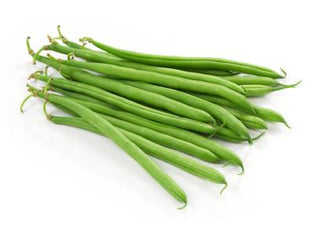(Phaseolus vulgaris)
Green beans belong to the legume family. Other members include shell beans such as pinto beans, kidney beans, and black beans. All of these beans are referred to as “common beans”, a tribute to a shared ancestor that originated thousands of years ago in Peru.
Traditionally referred to as string beans because of the trademark string running down the seam of the pod, today these beans are frequently called snap beans. (That well known string has been almost completely bred out.) Because they are picked while still immature, snap beans can easily be broken in half with a twist of the fingers. Today there are over 130 varieties of snap bean.
Common bean, snap bean, green bean – this slim bean, tapered into a slight point at either end, is not always green. The bean pods can come in a broad range of colors, including green, golden, purple, and red. One characteristic unique to green beans is that they are entirely edible and can be enjoyed fresh. Because the beans are picked before maturity, the pods are just beginning to form, making them sweet and pliable instead of the tough, fibrous pods of their mature counterparts.
The United States produces close to 60% of all commercially grown green beans, with millions of pounds pouring into the market fresh, frozen, and canned each year.
Nutrition Facts
Green beans are a dieter’s dream. A cup of these crunchy vegetables contains just 34 calories and boasts 4 grams of heart healthy fiber and 2 grams of protein.
Green beans are a good source of several vitamins. One serving contains 759 IUs of vitamin A (15% of the suggested daily intake), 17.9 mg of vitamin C (30% of the suggested daily intake), 40.7 mcg of vitamin K (20% of the suggested daily intake) and 40.7 mcg of folate (10% of the suggested daily intake). The vitamin A found in green beans is primarily from the phytonutrients lutein, zeaxanthin and beta carotene. The carotenoid content of green beans is comparable to several other carotenoid rich vegetables like carrots and tomatoes, although the vibrant carotenoid colors are hidden by the concentrated chlorophyll that gives most green beans their vibrant emerald color.
Green beans are also a good source of several essential minerals. A serving of green beans contains 12% of the suggested daily intake of manganese and about 7% of the suggested daily intake for magnesium and iron. Like many other green vegetables, green beans are a source of potassium, providing 230 mg per serving or 7% of daily values.
Although green beans are best enjoyed fresh, if you must make another selection, choose frozen. Green beans that are frozen and then cooked retain about 90% of their vitamin and mineral content whereas canned green beans lose up to a third of their of the phenolic compounds (important antioxidants) during the canning process.
Selection & Storage
Although green beans can be found in the grocery store year round they are at their best (and least expensive) while in season during late summer and fall.
When purchasing, your best option is to buy loose so you can select the highest quality beans. Green beans are a common vegetable garden crop and you should be able to find a fabulous selection at your local farmer’s market. When making your selection, look for beans that feel smooth, appear crisp and do not have bruising or brown spots. Beans should be a vibrant green with a firm texture – remember, you want beans that snap easily!
After making your selection, store green beans in a plastic bag in the refrigerator. For even better results, wrap your beans loosely in a damp paper towel before placing them in the bag. Stored in this way, green beans should remain fresh for up to a week.
Recipes
Green beans are often prepared steamed, boiled or stir-fried. With Thanksgiving fast approaching, many of us are probably anticipating Grandma’s heavy, creamy, green bean casserole. Although delicious, this dish is often laden with calories and fat.
This year, try saying thanks for good health by bringing one of these light, yet satisfying dishes to the table. Experiment with Sherried Green Beans and Mushrooms or try Citrus Green Beans with Pine Nuts as a perfect complement to the traditional heavy Thanksgiving fare. If you're looking for something different on a weeknight, try Pork, Cashew and Green Bean Stir Fry.
Fun Facts
Eating beans, pods and all, is a Native American custom. It was unheard of in other parts of the world until explorers returned to Europe bringing this unusual crunchy snack with them.

